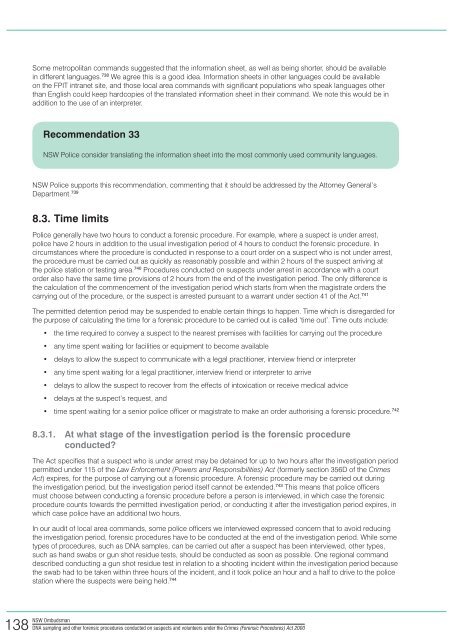Crimes (Forensic Procedures) Act 2000 - NSW Ombudsman - NSW ...
Crimes (Forensic Procedures) Act 2000 - NSW Ombudsman - NSW ...
Crimes (Forensic Procedures) Act 2000 - NSW Ombudsman - NSW ...
You also want an ePaper? Increase the reach of your titles
YUMPU automatically turns print PDFs into web optimized ePapers that Google loves.
Some metropolitan commands suggested that the information sheet, as well as being shorter, should be available<br />
in different languages. 738 We agree this is a good idea. Information sheets in other languages could be available<br />
on the FPIT intranet site, and those local area commands with significant populations who speak languages other<br />
than English could keep hardcopies of the translated information sheet in their command. We note this would be in<br />
addition to the use of an interpreter.<br />
Recommendation 33<br />
<strong>NSW</strong> Police consider translating the information sheet into the most commonly used community languages.<br />
<strong>NSW</strong> Police supports this recommendation, commenting that it should be addressed by the Attorney General’s<br />
Department. 739<br />
8.3. Time limits<br />
Police generally have two hours to conduct a forensic procedure. For example, where a suspect is under arrest,<br />
police have 2 hours in addition to the usual investigation period of 4 hours to conduct the forensic procedure. In<br />
circumstances where the procedure is conducted in response to a court order on a suspect who is not under arrest,<br />
the procedure must be carried out as quickly as reasonably possible and within 2 hours of the suspect arriving at<br />
the police station or testing area. 740 <strong>Procedures</strong> conducted on suspects under arrest in accordance with a court<br />
order also have the same time provisions of 2 hours from the end of the investigation period. The only difference is<br />
the calculation of the commencement of the investigation period which starts from when the magistrate orders the<br />
carrying out of the procedure, or the suspect is arrested pursuant to a warrant under section 41 of the <strong>Act</strong>. 741<br />
The permitted detention period may be suspended to enable certain things to happen. Time which is disregarded for<br />
the purpose of calculating the time for a forensic procedure to be carried out is called ‘time out’. Time outs include:<br />
• the time required to convey a suspect to the nearest premises with facilities for carrying out the procedure<br />
• any time spent waiting for facilities or equipment to become available<br />
• delays to allow the suspect to communicate with a legal practitioner, interview friend or interpreter<br />
• any time spent waiting for a legal practitioner, interview friend or interpreter to arrive<br />
• delays to allow the suspect to recover from the effects of intoxication or receive medical advice<br />
• delays at the suspect’s request, and<br />
• time spent waiting for a senior police officer or magistrate to make an order authorising a forensic procedure. 742<br />
8.3.1. At what stage of the investigation period is the forensic procedure<br />
conducted<br />
The <strong>Act</strong> specifies that a suspect who is under arrest may be detained for up to two hours after the investigation period<br />
permitted under 115 of the Law Enforcement (Powers and Responsibilities) <strong>Act</strong> (formerly section 356D of the <strong>Crimes</strong><br />
<strong>Act</strong>) expires, for the purpose of carrying out a forensic procedure. A forensic procedure may be carried out during<br />
the investigation period, but the investigation period itself cannot be extended. 743 This means that police officers<br />
must choose between conducting a forensic procedure before a person is interviewed, in which case the forensic<br />
procedure counts towards the permitted investigation period, or conducting it after the investigation period expires, in<br />
which case police have an additional two hours.<br />
In our audit of local area commands, some police officers we interviewed expressed concern that to avoid reducing<br />
the investigation period, forensic procedures have to be conducted at the end of the investigation period. While some<br />
types of procedures, such as DNA samples, can be carried out after a suspect has been interviewed, other types,<br />
such as hand swabs or gun shot residue tests, should be conducted as soon as possible. One regional command<br />
described conducting a gun shot residue test in relation to a shooting incident within the investigation period because<br />
the swab had to be taken within three hours of the incident, and it took police an hour and a half to drive to the police<br />
station where the suspects were being held. 744<br />
138<br />
<strong>NSW</strong> <strong>Ombudsman</strong><br />
DNA sampling and other forensic procedures conducted on suspects and volunteers under the <strong>Crimes</strong> (<strong>Forensic</strong> <strong>Procedures</strong>) <strong>Act</strong> <strong>2000</strong>

















